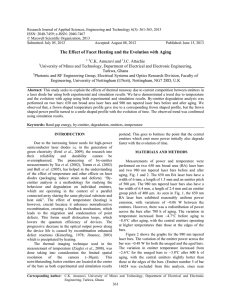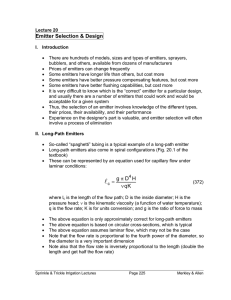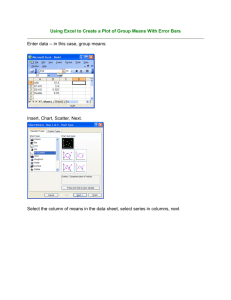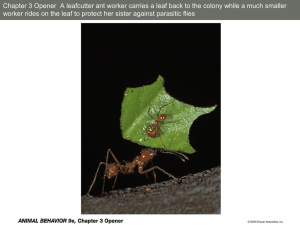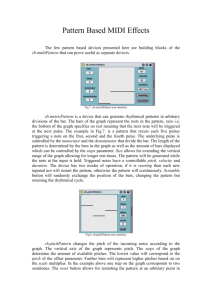poster paper template example
advertisement
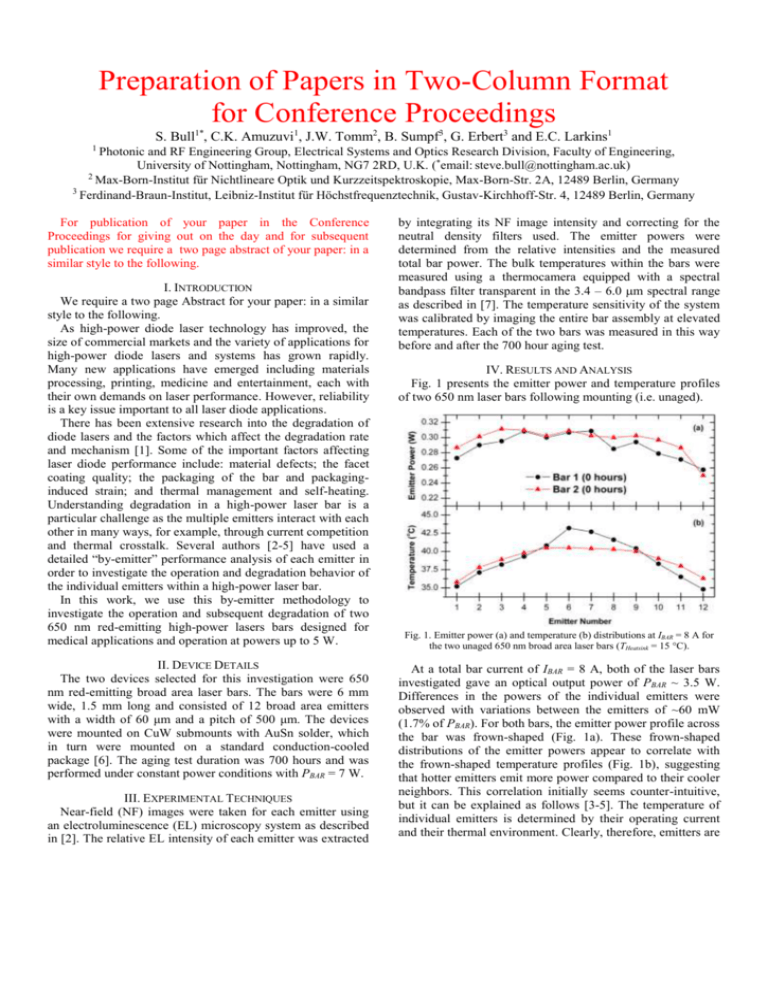
Preparation of Papers in Two-Column Format for Conference Proceedings S. Bull1*, C.K. Amuzuvi1, J.W. Tomm2, B. Sumpf3, G. Erbert3 and E.C. Larkins1 1 Photonic and RF Engineering Group, Electrical Systems and Optics Research Division, Faculty of Engineering, University of Nottingham, Nottingham, NG7 2RD, U.K. (*email: steve.bull@nottingham.ac.uk) 2 Max-Born-Institut für Nichtlineare Optik und Kurzzeitspektroskopie, Max-Born-Str. 2A, 12489 Berlin, Germany 3 Ferdinand-Braun-Institut, Leibniz-Institut für Höchstfrequenztechnik, Gustav-Kirchhoff-Str. 4, 12489 Berlin, Germany For publication of your paper in the Conference Proceedings for giving out on the day and for subsequent publication we require a two page abstract of your paper: in a similar style to the following. I. INTRODUCTION We require a two page Abstract for your paper: in a similar style to the following. As high-power diode laser technology has improved, the size of commercial markets and the variety of applications for high-power diode lasers and systems has grown rapidly. Many new applications have emerged including materials processing, printing, medicine and entertainment, each with their own demands on laser performance. However, reliability is a key issue important to all laser diode applications. There has been extensive research into the degradation of diode lasers and the factors which affect the degradation rate and mechanism [1]. Some of the important factors affecting laser diode performance include: material defects; the facet coating quality; the packaging of the bar and packaginginduced strain; and thermal management and self-heating. Understanding degradation in a high-power laser bar is a particular challenge as the multiple emitters interact with each other in many ways, for example, through current competition and thermal crosstalk. Several authors [2-5] have used a detailed “by-emitter” performance analysis of each emitter in order to investigate the operation and degradation behavior of the individual emitters within a high-power laser bar. In this work, we use this by-emitter methodology to investigate the operation and subsequent degradation of two 650 nm red-emitting high-power lasers bars designed for medical applications and operation at powers up to 5 W. II. DEVICE DETAILS The two devices selected for this investigation were 650 nm red-emitting broad area laser bars. The bars were 6 mm wide, 1.5 mm long and consisted of 12 broad area emitters with a width of 60 μm and a pitch of 500 μm. The devices were mounted on CuW submounts with AuSn solder, which in turn were mounted on a standard conduction-cooled package [6]. The aging test duration was 700 hours and was performed under constant power conditions with PBAR = 7 W. III. EXPERIMENTAL TECHNIQUES Near-field (NF) images were taken for each emitter using an electroluminescence (EL) microscopy system as described in [2]. The relative EL intensity of each emitter was extracted by integrating its NF image intensity and correcting for the neutral density filters used. The emitter powers were determined from the relative intensities and the measured total bar power. The bulk temperatures within the bars were measured using a thermocamera equipped with a spectral bandpass filter transparent in the 3.4 – 6.0 m spectral range as described in [7]. The temperature sensitivity of the system was calibrated by imaging the entire bar assembly at elevated temperatures. Each of the two bars was measured in this way before and after the 700 hour aging test. IV. RESULTS AND ANALYSIS Fig. 1 presents the emitter power and temperature profiles of two 650 nm laser bars following mounting (i.e. unaged). Fig. 1. Emitter power (a) and temperature (b) distributions at IBAR = 8 A for the two unaged 650 nm broad area laser bars (THeatsink = 15 °C). At a total bar current of IBAR = 8 A, both of the laser bars investigated gave an optical output power of PBAR ~ 3.5 W. Differences in the powers of the individual emitters were observed with variations between the emitters of ~60 mW (1.7% of PBAR). For both bars, the emitter power profile across the bar was frown-shaped (Fig. 1a). These frown-shaped distributions of the emitter powers appear to correlate with the frown-shaped temperature profiles (Fig. 1b), suggesting that hotter emitters emit more power compared to their cooler neighbors. This correlation initially seems counter-intuitive, but it can be explained as follows [3-5]. The temperature of individual emitters is determined by their operating current and their thermal environment. Clearly, therefore, emitters are heated by neighboring emitters and those at the bar centre will be hotter. Hotter emitters have a reduced bandgap energy, which in turn causes them to turn on earlier (i.e. at a lower voltage). As the emitters in a laser bar are connected in parallel, they share the same bias voltage. Therefore, those that turn on earlier (i.e. the hotter emitters at the centre of the bar) take a larger share of the total bar current and thus emit more power (assuming defect free, non-degraded emitters). It should be noted that the bandgap energy is also affected by packaging-induced strain as well as temperature. In these bars, the packaging-induced strain was found to be low and homogeneous, with the strain-induced changes in the bandgap energies being <0.5 meV across the bars. This is compared to temperature induced variations in the bandgap energies of ~2.8 meV, as calculated from the experimental data [5]. The situation described above (i.e. the hottest emitters have the highest optical output powers) cannot, however, continue indefinitely as thermal rollover and defect-related (i.e. nonradiative) recombination also increase rapidly with increasing temperature. Following the measurements presented in Fig. 1, the bars were operated for 700 hours as described previously. Figs. 2 and 3 show the emitter power and temperature profiles following the aging test for ‘Bar 1’ and ‘Bar 2’, respectively. In both bars, the temperature profile remains frown-shaped following aging with a small (1-2 °C) increase in the average temperature being observed in both bars. Fig. 3. Emitter power (a) and temperature (b) distributions at IBAR = 8 A for ‘Bar 2’ before and after 700 hours of aging (THeatsink = 15 °C). Following the aging, significant differences in the emitter power profiles of both bars were observed. Globally, the total output powers of both bars dropped by ~0.6 W. However, on the emitter level, the power profile is smile-shaped following aging with lower power emitters in the bar centre compared to emitters at the bar edges. Given the initial power profile shape before aging, this is not surprising as the centre emitters were being driven harder (i.e. drawing more current) and operating at higher temperatures. Thermal rollover is reached in these emitters sooner and non-radiative recombination increases faster in these emitters than in those towards the bar edges. The more central emitters therefore begin to degrade first. V. CONCLUSION The temperature of the laser bars investigated here is found to have a major impact on current competition and the emitter power distribution. Prior to aging, a strong correlation is seen between the emitter power and temperature distributions, where the hottest central emitters have higher optical output powers. Following aging, this situation is reversed and as a result of temperature effects and current competition between emitters, the degradation of these bars begins with the centre emitters and works outwards towards the edge emitters. Fig. 2. Emitter power (a) and temperature (b) distributions at IBAR = 8 A for ‘Bar 1’ before and after 700 hours of aging (THeatsink = 15 °C). REFERENCES [1] J.W. Tomm, J. Jimenez (eds.), Quantum Well Laser Array Packaging. New York, NY: McGraw-Hill, 2007. [2] R. Xia, et al., “Mounting-induced strain threshold for the degradation of high-power AlGaAs laser bars,” IEEE Photonics Technol. Lett., vol. 14, pp. 893-895, 2002. [3] S. Bull, et al., “By-emitter degradation analysis of high-power laser bars,” J. Appl. Phys., vol. 98, 63101, 2005. [4] S. Bull, et al., “Identification of degradation mechanisms in high-power laser bars using by-emitter degradation studies,” J. Mater. Sci. – Mater. Electron., vol. 19, pp. S145-S149, 2008. [5] C.K. Amuzuvi, et al., “The impact of temperature and strain-induced band gap variations on current competition and emitter power in laser bars,” Appl. Phys. Lett., vol. 98, 241108, 2011. [6] B. Sumpf, et al., “3W broad area lasers and 12W bars with conversion efficiencies up to 40% at 650nm,” IEEE J. Sel. Top. Quantum Electron., vol. 13, pp. 1188-1193, 2007. [7] M. Zeigler, et al., “Transient thermal properties of high-power diode laser bars,” Appl. Phys. Lett,. vol. 89, 263506, 2006.
